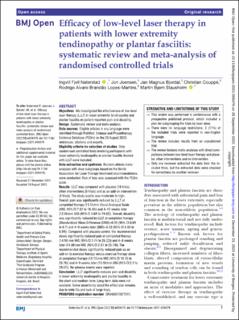| dc.contributor.author | Naterstad, Ingvill Fjell | |
| dc.contributor.author | Joensen, Jon | |
| dc.contributor.author | Bjordal, Jan Magnus | |
| dc.contributor.author | Couppé, Christian | |
| dc.contributor.author | Lopes-Martins, Rodrigo Alvaro Brandão | |
| dc.contributor.author | Stausholm, Martin Bjørn | |
| dc.date.accessioned | 2022-12-30T12:13:21Z | |
| dc.date.available | 2022-12-30T12:13:21Z | |
| dc.date.created | 2022-11-17T10:48:47Z | |
| dc.date.issued | 2022 | |
| dc.identifier.issn | 2044-6055 | |
| dc.identifier.uri | https://hdl.handle.net/11250/3040080 | |
| dc.description.abstract | Objectives We investigated the effectiveness of low-level laser therapy (LLLT) in lower extremity tendinopathy and plantar fasciitis on patient-reported pain and disability.
Design Systematic review and meta-analysis.
Data sources Eligible articles in any language were identified through PubMed, Embase and Physiotherapy Evidence Database (PEDro) on the 20 August 2020, references, citations and experts.
Eligibility criteria for selection of studies Only randomised controlled trials involving participants with lower extremity tendinopathy or plantar fasciitis treated with LLLT were included.
Data extraction and synthesis Random effects meta-analyses with dose subgroups based on the World Association for Laser Therapy treatment recommendations were conducted. Risk of bias was assessed with the PEDro scale.
Results LLLT was compared with placebo (10 trials), other interventions (5 trials) and as an add-on intervention (3 trials). The study quality was moderate to high.
Overall, pain was significantly reduced by LLLT at completed therapy (13.15 mm Visual Analogue Scale (VAS; 95% CI 7.82 to 18.48)) and 4–12 weeks later (12.56 mm VAS (95% CI 5.69 to 19.42)). Overall, disability was significantly reduced by LLLT at completed therapy (Standardised Mean Difference (SMD)=0.39 (95% CI 0.09 to 0.7) and 4–9 weeks later (SMD=0.32 (95% CI 0.05 to 0.59)). Compared with placebo control, the recommended doses significantly reduced pain at completed therapy (14.98 mm VAS (95% CI 3.74 to 26.22)) and 4–8 weeks later (14.00 mm VAS (95% CI 2.81 to 25.19)). The recommended doses significantly reduced pain as an add-on to exercise therapy versus exercise therapy alone at completed therapy (18.15 mm VAS (95% CI 10.55 to 25.76)) and 4–9 weeks later (15.90 mm VAS (95% CI 2.3 to 29.51)). No adverse events were reported.
Conclusion LLLT significantly reduces pain and disability in lower extremity tendinopathy and plantar fasciitis in the short and medium term. Long-term data were not available. Some uncertainty about the effect size remains due to wide CIs and lack of large trials. | en_US |
| dc.language.iso | eng | en_US |
| dc.publisher | BMJ | en_US |
| dc.rights | Navngivelse-Ikkekommersiell 4.0 Internasjonal | * |
| dc.rights.uri | http://creativecommons.org/licenses/by-nc/4.0/deed.no | * |
| dc.title | Efficacy of low-level laser therapy in patients with lower extremity tendinopathy or plantar fasciitis: systematic review and meta-analysis of randomised controlled trials | en_US |
| dc.type | Journal article | en_US |
| dc.type | Peer reviewed | en_US |
| dc.description.version | publishedVersion | en_US |
| dc.rights.holder | Copyright 2022 The Author(s) | en_US |
| dc.source.articlenumber | e059479 | en_US |
| cristin.ispublished | true | |
| cristin.fulltext | original | |
| cristin.qualitycode | 1 | |
| dc.identifier.doi | 10.1136/bmjopen-2021-059479 | |
| dc.identifier.cristin | 2075395 | |
| dc.source.journal | BMJ Open | en_US |
| dc.identifier.citation | BMJ Open. 2022, 12 (9), e059479. | en_US |
| dc.source.volume | 12 | en_US |
| dc.source.issue | 9 | en_US |

